As we celebrate World Radio Day on 13 February, Pulugurta Chandra Sekhar traces the history of agricultural broadcasting in India and argues why the Radio is still relevant for agricultural development in India.
INTRODUCTION
Agriculture has gone through a series of revolutions that has made it more efficient, productive, and profitable. Market predictions for the next ten years say the next significant change will be a digital agricultural revolution’. It will help agriculture meet the future needs of the world’s growing population. ‘Digital ecosystems’ – resources, skills, and networks – tend to be more robust in urban areas than in rural ones. There is a chance that digitization will make the differences between rural and urban areas worse, especially when it is combined with global urbanization trends and the movement of middle class and wealthy people to urban centres. To ensure that everyone can participate in the emerging digital society, All India Radio is dedicated to assisting governments and partners in bridging such multi-disciplinary digital divides. Moreover, India has embarked on a massive programme to connect six lakh villages through optical fibre cable laying and internet connectivity. The mission is essentially to lay an information superhighway to extend broadband connectivity to Gram Panchayats.
BRIDGING THE DIGITAL DIVIDE
Radio is one of the most crucial forms of communication that can effectively close the knowledge gaps in the agricultural community. Radio broadcasting is especially effective for farmers who are illiterate and therefore unable to learn about new farming techniques and practices worldwide. Consequently radio is turning traditional farmers into more forward thinking and creative ones as they use these scientific, innovative, and easier ways to grow crops. The radio has changed from a one-way medium to a two-way platform where experienced farmers can give their peers advice and share new ideas. All India Radio (AIR), a public broadcaster that informs, educates, and entertains, has been actively playing a unique role in bridging the digital divide and supporting agricultural extension programmes in India.
THE GENESIS OF FARM RADIO BROADCAST IN INDIA
The experiment in 1952-53 was none other than ‘An Indian Experiment in Farm Radio Forums’ at Poona (now Pune). The goal of this experiment was to create a two-way channel of interaction between the people listening in villages and the radio station’s programmers; it was based on the Canadian Model. The original purpose of farm forums and village listening clubs was to facilitate better listening and to gather content for radio and television programmes. To this end, AIR placed rural supervisors in charge of specific broadcasting locations. When the chance arose in 1955-56 to test out farm forums modelled after those in Canada, these clubs were already up and running, albeit mechanically. It involved carefully orchestrated broadcasts, the organization of listening and discussion groups, and a rigorous scientific evaluation of audience responses.
Format
News, market rates, and weather reports; informative talks and discussions of interest to rural listeners; plays, skits, and features; music, mostly folk music; and items of particular interest to women and children made up the bulk of the rural programme’s primary content. A typical day’s worth of the show lasted between 45 and 60 minutes. Successful specials included discussions with agricultural experts known as Krishi pandits, broadcasts from model villages, and even the occasional quiz show. Traditional forms of rural entertainment, such as folk music and rural plays, were exceptionally well-received.
Chupal (Village Club)
Over time, a tried and true method of presenting programming has emerged: a chupal (village club) of four or five elders led by someone who speaks the standard regional language (which may or may not be the same for everyone). Throughout an hour of lighthearted entertainment and informative performances, these persons would drop nuggets of advice and guidance into their casual conversation.
Stock Characters
Several stations have developed ‘stock characters’ to inject some informality into the broadcast, which is fine in theory but leaves room for improvement in practice. One of them is a charismatic former soldier with a quirky personality. An excellent case in point is Loha Singh, the protagonist of a radio play by the same name produced and broadcast by All India Radio, Patna, since 2009.
Broadcast Schedules
The 20 episodes aired as part of the daily rural hour programme from February 19 to April 26 1956, (twice weekly, on Sundays and Thursdays) lasted for 30 minutes, from 6:30 pm to 7 pm. Poona Station was required to air regular rural programming throughout this period, so the regular rural hour was broadcast on other days.
It was possible to experiment with various approaches within the bounds of the overall pattern. Features on village pests and hygiene were produced in the traditional folk drama style and radio play formats, respectively. Folk songs, bhajans (devotional songs), and light music were often interspersed with or followed certain features. Several shows used humour to highlight the differences between traditional and modern ways of living. Originally called ‘Farm Forum’, the name was changed to ‘Radio Rural Forum’ when it was picked up on a national scale to reflect the show’s expanded focus beyond agriculture.
Farm & Home Units
In 1965 it was decided to establish Farm & Home Units in ten AIR Stations in order to take intensive Agricultural District Programmes and Intensive Agricultural Area Programmes to the farming community. This was done so as to offer farmers in small, homogeneous areas with similar agro-climatic conditions with timely, problem-oriented technical information.
In 1966, with the arrival of new ‘wonder’ seeds – the high-yielding varieties – the Farm and Home Units of Akashvani were established. The ADT-27 rice strain was one such example. The Indian Government announced a new initiative for the next decade called the High Yielding Varieties Programme. Outside Broadcast (OB) vans were given to 30 stations that were intensive agricultural areas where agricultural district programmes were active.
By March 1985, there were 64 Farm and Home Units in place. Now a Farm and Home Unit exists at all AIR stations. Research shows that semi-educated farmers listen to the Farm and Home Broadcasts for the agricultural advice they provide, thereby increasing their productivity and income. A further innovative programme broadcast by AIR was intensive nutrition programmes in coordination with District Health Services.
|
Box 1: Radio Rice |
Farm School on Air
Farm School on Air was another breakthrough in rural radio that was introduced in the year 1973. With this farmers’ interest in and willingness to learn modern farming methods increased. The invention of the transistor altered listening habits in rural and urban centres. Whoever couldn’t afford to have such a set to provide all the information necessary to run a farm and get the best out of what he has was considered to be a poor landowner.
Listeners of ‘Radio Krishi Shiksha’ are also avid consumers of the ‘Krishi Jagat’ programme, which needs to be noted. It teaches us not to ignore tried-and-true elements of our programmes in favour of shiny new things when implementing change.
Non-Formal Education
Non-formal education is exemplified by AIR’s substantial output of farm broadcasting and by another innovation from the 1970s aimed at rural listeners. Non-formal education broadcasts for rural youth groups between the ages of 15 and 25 have begun on AIR’s five stations in Srinagar, Nagpur, Tiruchi, Simla, and Jaipur.
Additionally, it is distinct from AIR’s standard Farm and Home Programme in both approach and focus; the former is targeted and needs-based, the latter is geographically specific, covering a particular agro-climatic zone and concentrating on field-based activities. Ninety per cent of the programs are captured on location, in the field, rather than having farmers and experts take part in these Programs. This show is available in every major language and dialect spoken in the country.
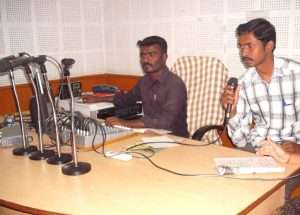 Recording of a radio programme ©CRISP
Recording of a radio programme ©CRISP
Local Radio Stations
All India Radio brought Local Radio Stations (LRSs) and FM radio channels in the third tier in 96 operational cities. LRS is a new theory in broadcasting in India introduced in 1980. LRS differs from the regional network due to its down-to-earth, intimate, uninhibited approach and area-specific programmes. They are flexible and spontaneous, enabling the station to function as the mouthpiece of the local community. It demolished the division between the broadcaster and the audience. Local authorities, police, emergency services, adult educationists, schools, transporters, farm scientists, and entertainers look to local radio for sustained community service. Another innovative method is a two-way communication system between the listeners and Extension Agencies of various Government Departments. Flexibility in programming is the main characteristic of field-based programmes.
Narrowcasting
AIR recently took a step to get closer to the people, even though it already had a segment called ‘Farm and Home’ in its regular terrestrial broadcasts. This was especially necessary for the farming community, which was reached through Narrowcasting, another innovative method.
The buzzword in broadcasting right now is ‘narrowcasting’. It means covering smaller areas with programmes that are tailored specifically to those areas. It makes the relationship between the medium and the people stronger. Narrowcasting is a catch-all term for radio and TV signals that can only be heard or seen by ‘subscription customers’. Broadcasts are sent out to the public, and anyone with a receiver that can pick up the signal can listen to them. Community radio is another type of narrowcasting. Thus began the story of Kisanvani.
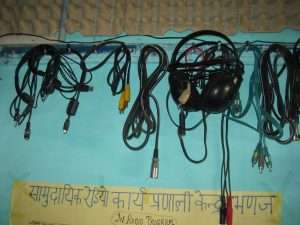 Community Radio Transmission Centre, Bhanaj Village, Rudraprayag District, Uttarakhand ©CRISP
Community Radio Transmission Centre, Bhanaj Village, Rudraprayag District, Uttarakhand ©CRISP
Kisanvani – Another Innovative Programme
All India Radio has always been committed to helping farmers. Still, on February 15, 2004, it started a new project called narrowcasting to turn its hard-core agriculture programme into ‘The Voice of Farmers’, or ‘Kisvanvani’. Now, the Kisanvani Programme is being played on all of AIR’s LRS stations and some primary stations all over the country. The main goal of the Kisanvani Program is to teach farmers about things like ‘diffusion of innovation’, ‘Lab to land’, ‘knowledge and skill of modern and scientific techniques of agricultural practises’, ‘horticulture’, ‘animal husbandry’, ‘poultry farming’, ‘fishery’, ‘rural banking and self-employment schemes’, and allied activities.
|
Box 2: Format of the Kisan Vani Programme AIR’s Kisan Vani Stations broadcasts quickies made by the Agriculture Department on topics such as ‘Seed treatment’, ‘Precautions when buying seeds’, ‘Intercropping’, ‘Precautions when buying pesticides’, ‘Integrated Pest Management’, ‘Fertilizer Management’, and ‘National Food Security Mission on Paddy and pulses’ by making good use of Free commercial time to help farmers learn about new technologies that can help them make more and better crops. Kisanvani has a wide range of formats, including Aaj Ki Khabrein (the news of the day), Aaj ka Bazar (the market of the day), Aaj Ka Mausam (weather information), Aaj Ki Batein (the special news of the day), Aaj Ke Kisan (an interview with the farmer of the day), and Desh Videsh (news from the country and abroad). |
The country is heading for a digital revolution in the agricultural sector in the coming years. From the Indian Finance Minister’s speech about the 2023 budget, it’s clear that India wants to focus on green agriculture, millet production (since the UN has declared 2023 as the International Year of Millet), a green transition in the energy sector with the use of ethanol and biofuel, and adding value through the circular economy. All these require people’s participation. Systematic campaigns through Radio media with all its digital modes will be a great catalyst. However, it should be noted that, while radio stations enjoyed relative independence for decades, the ongoing media convergence has put them in direct conflict with other media outlets. In this digital age, Radio faces tough competition from private television channels in farm broadcasting.
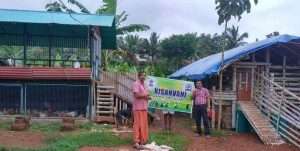 Recording of Kisan Vani Programme -© AIR, Kannur
Recording of Kisan Vani Programme -© AIR, Kannur
CONTINUING RELEVANCE OF RADIO IN TODAY’S DIGITAL ERA
After the internet, radio is one of India’s fastest-growing industries today. It’s free of charge, unlike cable or satellite TV, and it’s also locally focused and interactive. Radio is a powerful and appealing medium since it can go everywhere, costs very little, reaches a large audience, and requires minimal effort from its audience. Moreover, AIR’s terrestrial signal reaches 99.20% of the population across 92% of the country.
Radio’s distinct qualities are its portability and accessibility. It is the primary source of news and information in many rural areas of India. It’s still the cheapest and most convenient option. In today’s digital age, radios are even available on mobile phones and you can easily bring one to the farm without worrying about it being too bulky. With the decreasing size of radio sets, the portability of radio receivers has increased throughout the years, contributing to radio’s growing significance as a complementary medium. This means that most radio listening takes place in the context of another activity, such as farming, cooking, cleaning, or driving. Over the years the radio broadcasts evolved in various forms, including tales, articles, interviews, and audio dramas. During natural disasters such as floods and earthquakes, the All India Radio has also provided invaluable services.
CONCLUSION
During the course of AIR’s 87 years it has become an indispensable resource for farmers across the subcontinent. Several farmers and farm communities have benefited from its efforts to alter agricultural practices across the country. This proves that radio can be an effective tool for agricultural progress and expansion if used correctly. With the advancement of technology, the largest radio network in the world, All India Radio, has switched to narrow broadcasting from broadcasting to better serve the farming community through a more collaborative method of reaching out to individuals in rural areas.
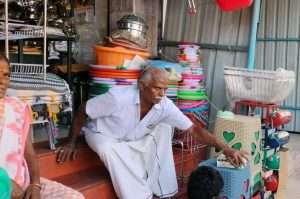 A shop owner listening to Radio while waiting for customers © Alagu Niranjan D
A shop owner listening to Radio while waiting for customers © Alagu Niranjan D
All India Radio has made a significant impact in the field of agricultural extension. It has persisted in its pursuit of improvement, adapting and modernizing as necessary to incorporate new and better presentation and communication formats and contents to achieve its goal.
Most significantly, radio allows listeners to make the experience their own by challenging them to use their imagination while trying to make sense of what’s happening. “TV gives everyone an image, but radio gives birth to a million images in a million brains,” wrote American author Margaret ‘Peggy’ Noonan. Her lines capture the essence of Radio’s enormous adaptability and continuous relevance in an era that places a premium on personalized media.
 Pulugurta Chandra Sekhar has a Doctorate in Mass Communication and Journalism and is currently working with Prasar Bharati, New Delhi. His association with Doordarshan and All India Radio is 35 years old. His forte is Radio Broadcasting, Community Radio and New Media. He can be reached at email: pcsekhar2000@yahoo.com
Pulugurta Chandra Sekhar has a Doctorate in Mass Communication and Journalism and is currently working with Prasar Bharati, New Delhi. His association with Doordarshan and All India Radio is 35 years old. His forte is Radio Broadcasting, Community Radio and New Media. He can be reached at email: pcsekhar2000@yahoo.com

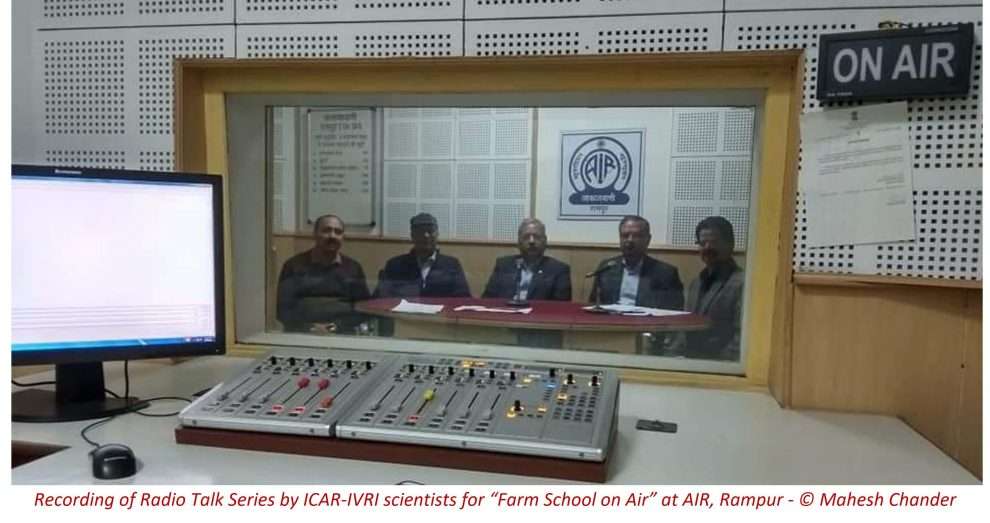

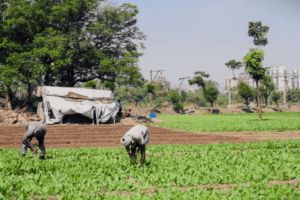

Great innovation for the benefit of farmers for all times to come. Well explained and articulated by an experienced specialist actively involved in its promotion. Congratulations.
Happy to go through this stimulating post! No doubt, RADIO IS STILL AN IMPORTANT SOURCE OF INFORMATION FOR FARMERS ! it depends on format we are using for information dissemination, if it is interactive, participatory, engaging, innovative giving latest information to it’s listeners,would be more effective. FM channels are very popular for music can be impactful for agricultural programmes too! We at IVRI started involving farmers in radio programmes rather than giving straight talks all the time, also radio live in also make programmes interesting. There is need for continuous efforts to work on farmer participatory formats like recordings in the farmers’ fields talking to them. Thanks & congratulations to Dr Chandra Sekher for sharing his experiences and telling us why radio still happens to be a powerful medium for sharing information with small scale farmers in particular. Congratulations to AESA too for bringing out such informative and stimulative blogs on regular basis.